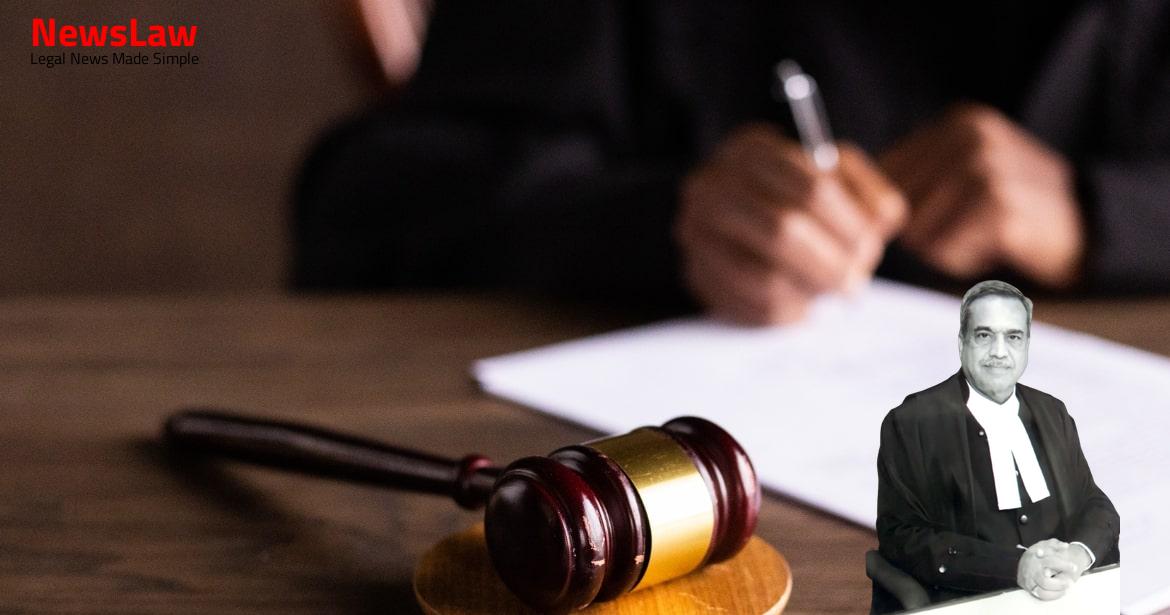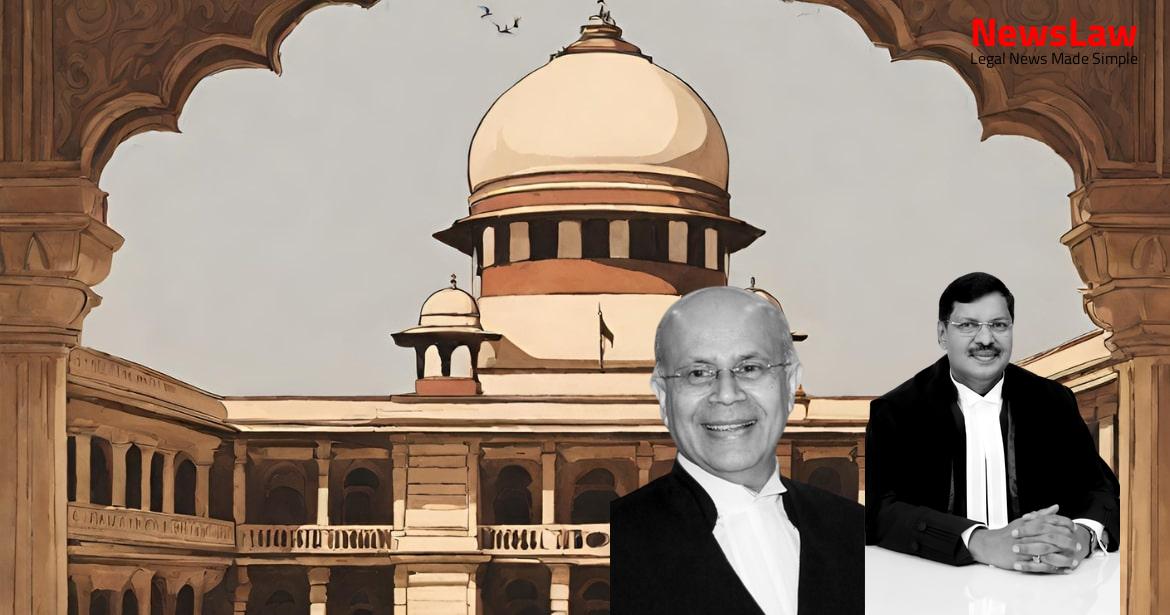The legal analysis in this case focuses on the intricate details considered by the court in upholding the conviction after the trial court’s acquittal was reversed. The High Court’s thorough evaluation of evidence, including multiple dying declarations, and the analysis of witness credibility and circumstantial evidence played a crucial role in the final verdict. This case highlights the significance of judicial scrutiny in ensuring justice is served. Stay tuned for more insights into the court’s legal reasoning in this nuanced case.
Facts
- The appellant, original accused no.1, appealed against the judgment of conviction by the High Court for offences under Sections 498A and 302 read with 34 of the IPC.
- The State of Karnataka also appealed against the trial court’s judgment of acquittal.
- The trial court had acquitted all the accused due to lack of belief in the dying declaration and contradictions in two dying declarations.
- The High Court reversed the acquittal of the appellant, convicting them for the mentioned offences, while confirming the acquittal of original accused nos. 2 and 3.
- Original accused no.1 appealed against the High Court’s judgment of conviction.
- Original accused no.1 married the deceased, daughter of PW3 & PW4 nine years ago.
- Deceased was taken to the hospital and her statement was recorded as Exhibit P5.
- Chargesheet filed against all accused for offences under Sections 498A and 302 read with 34 of the IPC.
- Trial conducted in the learned Sessions Court with accused pleading not guilty.
- Prosecution presented 14 witnesses, documentary evidences including dying declaration (Exhibit P5) and medical evidence.
- Incident on 24.06.2010 where accused no.1 quarreled with his wife and set her on fire using kerosene in their matrimonial home.
- Further statements of the accused were recorded under Section 313 Cr. P.C.
- Investigating officer recorded deceased’s statement on 27.06.2010 (Exhibit P5).
- Allegations of mental cruelty, dowry demand from the deceased’s parents, and mediation where money was given by PW3 & PW4.
Also Read: Electoral Malpractices in Mayor Election
Arguments
- Concerns raised regarding the credibility of the dying declaration recorded by PW10, as it was done in the presence of multiple individuals.
- Possibility of the deceased being tutored to make a statement against the accused is brought up, implying doubt in the confession.
- Defense version highlights the absence of power supply during the incident, leading to the use of a kerosene stove which resulted in accidental fire according to an earlier dying declaration (Exhibit D2).
- Inconsistencies between the two dying declarations, with Exhibit D2 being the first one believed by the trial court, are emphasized as a reason for acquittal.
- The appellant rushing to extinguish the fire and sustaining burn injuries is pointed out as evidence supporting innocence.
- Criticism of the High Court for not considering key circumstances present during the incident and the recording of the later dying declaration (Exhibit P5).
- Argument made against the High Court’s jurisdiction in reversing the well-reasoned acquittal judgment by the trial court.
- Interference by the appellate court is warranted only if the findings of the trial court are found to be perverse.
- Just because the trial court’s judgment resulted in an acquittal does not validate the appellate court setting it aside based on the prosecution’s evidence alone.
- The High Court should not have overturned the trial court’s judgment unless it was deemed to be perverse.
Also Read: Balancing Power and Transparency: Electoral Bonds Struck Down, Disclosure Mandated
Analysis
- The High Court evaluated both dying declarations independently and concluded that dying declaration recorded as Exhibit P5 reflects the true state of affairs supported by medical evidence and injuries sustained by the deceased.
- The defence’s claim of accidental fire was disbelieved by the High Court considering the circumstances of the injuries sustained by the deceased.
- The act of pouring kerosene on the deceased and setting her on fire was considered punishable for murder as per the evidence and dying declarations.
- The intention to kill was present based on the accused’s actions and knowledge of consequences, leading to the offense of murder.
- The High Court correctly re-evaluated the entire evidence independently and found the trial court’s findings to be wrong, justifying the reversal of the acquittal.
- Each dying declaration was independently considered for its evidentiary value, and the High Court relied on the second declaration due to its reliability and circumstantial support.
- The accused’s attempt to extinguish the fire after setting the deceased ablaze did not mitigate the offense of murder, as the act of setting her on fire was intentional.
- The High Court’s decision to convict the accused was based on a thorough evaluation of the evidence and the circumstances surrounding the crime.
- The Court considered various decisions from its past judgments regarding appeals against acquittals.
- The principle was reiterated that an act committed knowingly differs from one done in a highly inebriated state.
- The weight given to the trial court’s findings on witness credibility, presumption of innocence, and benefit of doubt was emphasized.
- The need for compelling circumstances to interfere with an acquittal order was highlighted.
- The Court discussed the issue of perversity in findings of fact and the circumstances under which interference is justified.
- Specific cases of atrocities against women leading to their death were mentioned, emphasizing the need for stern action in such cases.
- The Court examined the distinction between murder and culpable homicide not amounting to murder in a case involving burning of a wife.
- The importance of not lightly interfering with acquittal orders unless for strong reasons was reiterated.
- Instances were cited where the High Court could justify interference in an acquittal judgment.
- The significance of the presumption of innocence and the need for evidence to be reliable for conviction were underlined.
- The Court emphasized society’s need to address crimes against women with severity and as a social evil.
- The High Court conviction of the accused under Section 302 IPC is justified.
- The accused poured kerosene on the deceased and set her ablaze with a matchstick.
- This act was imminently dangerous and highly likely to cause death.
Also Read: Recall of Resolution Plan Approval: Legal Analysis
Decision
- The Court sees no reason to interfere with the judgement and order of conviction passed by the High Court.
- The present appeal fails and deserves to be dismissed.
- The appeal is accordingly dismissed.
Case Title: NAGABHUSHAN Vs. THE STATE OF KARNATAKA (2021 INSC 159)
Case Number: Crl.A. No.-000443 / 2020



